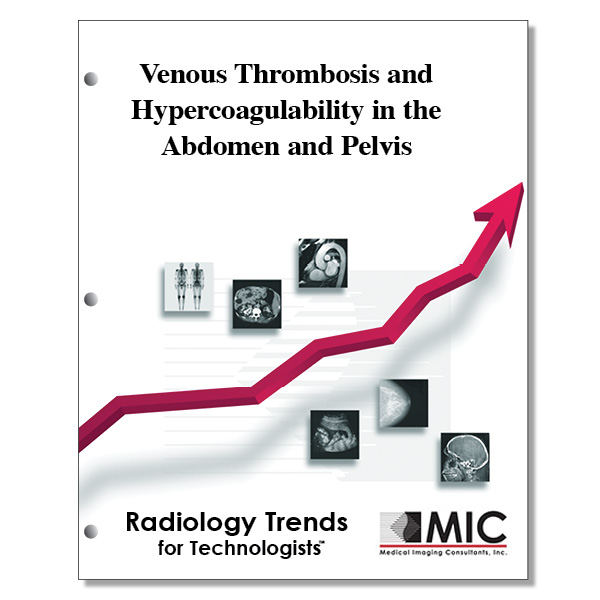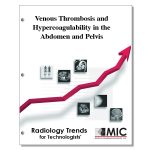

Venous Thrombosis and Hypercoagulability in the Abdomen and Pelvis
A review of the multimodality imaging findings of thrombosis, the spectrum of pathologic entities that can increase the risk of thrombosis, and the potential complications of these hypercoaguable conditions.
Course ID: Q00629 Category: Radiology Trends for Technologists Modalities: CT, MRI, Sonography, Vascular Interventional3.0 |
Satisfaction Guarantee |
$34.00
- Targeted CE
- Outline
- Objectives
Targeted CE per ARRT’s Discipline, Category, and Subcategory classification:
[Note: Discipline-specific Targeted CE credits may be less than the total Category A credits approved for this course.]
Computed Tomography: 2.50
Procedures: 2.50
Abdomen and Pelvis: 2.50
Magnetic Resonance Imaging: 2.50
Procedures: 2.50
Body: 2.50
Registered Radiologist Assistant: 3.00
Procedures: 3.00
Neurological, Vascular, and Lymphatic Sections: 3.00
Sonography: 2.50
Procedures: 2.50
Abdomen: 2.50
Radiation Therapy: 1.00
Procedures: 1.00
Treatment Sites and Tumors: 1.00
Vascular-Interventional Radiography: 1.00
Procedures: 1.00
Vascular Diagnostic Procedures: 1.00
Vascular Sonography: 2.50
Procedures: 2.50
Abdominal/Pelvic Vasculature: 2.50
Outline
- Introduction
- Pathophysiology of Venous Thrombus
- Multimodality Imaging Findings of Thrombus
- Causes of Thrombosis
- Malignancy
- Renal Cell Carcinoma
- Hepatocellular Carcinoma
- Adrenal Cortical Carcinoma
- Neuroendocrine Tumors
- Trousseau Syndroma
- Prothrombotic Events
- Postprocedural Complications
- Immobility
- Infectious Conditions
- Lemierre Syndrome
- Pylephlebitis
- Anatomic Conditions
- May-Thurner Syndrome
- Genetic Conditions
- Factor V Leiden Mutation
- Antithrombin, Protein C, and Protein S Deficiencies
- JAK2 Gene Mutations
- Paroxysmal Nocturnal Hemoglominuria
- Miscellaneous Conditions
- Budd-Chiari Syndrome
- Portal Vein Thrombosis
- Pitfalls: Slow Flow
- Malignancy
- Conclusion
Objectives
Upon completion of this course, students will:
- be familiar with imaging modalities used for evaluation of vascular structures
- be familiar with the 30-day mortality rates associated with PE
- be familiar with the Virchow triad
- identify the carcinomas associated with direct tumor invasion into the vasculature
- be familiar with risk factors for VTE
- identify the modality of choice for evaluation of venous thrombosis in the extremities
- recognize the limitation for US for diagnosis of DVT
- recognize the hallmark feature of acute thrombus on CT
- identify the viable means of assessing lower extremity vascularization in patients whom US may not be practical
- identify an accurate alternative to CT pulmonary angiography for detection of PE
- be familiar with the significance of a clot on staging, prognosis, and treatment of a tumor
- be familiar with the frequency of renal cell carcinoma
- be familiar with the characteristics of a tumor thrombus on CT and MRI
- be familiar with management strategies for the patient with tumor thrombus
- be familiar with the occurrence of adrenal cortical carcinoma
- be familiar with the syndrome caused by adrenal cortical carcinoma
- be familiar with the classifications for pancreatic neuroendocrine tumors
- be familiar with the definition Trousseau syndrome
- identify the technical issues occurring during transplantation
- identify the common causes for transient immobility
- understand the VTE risks associated with orthopedic surgery
- be familiar with Lemierre syndrome
- identify the diagnostic modality of choice for imaging patients with Lemierre syndrome
- be familiar with the causes for pylephlebitis
- recognize the organisms associated with pylephlebitis
- be familiar with the treatments for patients suffering with pylephlebitis
- be familiar with May-Thurner syndrome
- identify the reference standard for diagnosis of May-Thurner syndrome
- be familiar with the pathologic basis for factor V Leiden mutation
- identify which patient population is most associated with factor V Leiden mutation
- be familiar with the environmental factors increasing risk of thrombosis in factor V Leiden patients
- recognize the deficiencies associated with inherited thrombophilia
- be familiar with frequency of thrombotic events due to protein C and protein S deficiencies
- be familiar with the gene associated with common causes of splanchnic vein thromboses
- be familiar with the first manifestation for unexplained splanchnic vein thrombosis
- identify the imaging modality of choice for patients with paroxysmal nocturnal hemoglobinuria (PNH)
- be familiar with Budd-Chiari syndrome
- identify the common risk factors for the development of portal vein thrombosis
- be familiar with a CT artifact that masquerades as a thrombosis
- be familiar with an MRI artifact that can create misallocation in the images
